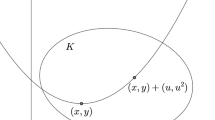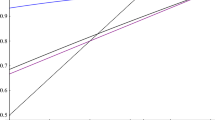Abstract
We provide several new answers on the question: how do radial projections distort the dimension of planar sets? Let \(X,Y \subset \mathbb{R}^{2}\) be non-empty Borel sets. If X is not contained in any line, we prove that
If dimHY>1, we have the following improved lower bound:
Our results solve conjectures of Lund-Thang-Huong, Liu, and the first author. Another corollary is the following continuum version of Beck’s theorem in combinatorial geometry: if \(X \subset \mathbb{R}^{2}\) is a Borel set with the property that dimH(X ∖ ℓ)=dimHX for all lines \(\ell \subset \mathbb{R}^{2}\), then the line set spanned by X has Hausdorff dimension at least min{2dimHX,2}.
While the results above concern \(\mathbb{R}^{2}\), we also derive some counterparts in \(\mathbb{R}^{d}\) by means of integralgeometric considerations. The proofs are based on an ϵ-improvement in the Furstenberg set problem, due to the two first authors, a bootstrapping scheme introduced by the second and third author, and a new planar incidence estimate due to Fu and Ren.
Similar content being viewed by others
Notes
The upper bound for “K1” in Lemma 3.18 also depends on the lower bound for ϵ>0, so the argument here does not show that (μ,ν) has (t−1+η,K1,1)-thin tubes. This would indeed be false in general.
References
Beck, J.: On the lattice property of the plane and some problems of Dirac, Motzkin and Erdős in combinatorial geometry. Combinatorica 3(3–4), 281–297 (1983)
Bond, M., Łaba, I., Zahl, J.: Quantitative visibility estimates for unrectifiable sets in the plane. Trans. Am. Math. Soc. 368(8), 5475–5513 (2016)
Csörnyei, M.: On the visibility of invisible sets. Ann. Acad. Sci. Fenn., Math. 25(2), 417–421 (2000)
Dąbrowski, D., Orponen, T., Villa, M.: Integrability of orthogonal projections, and applications to Furstenberg sets. Adv. Math. 407, Paper No. 108567, 34 (2022)
Dote, P., Gan, S.: Exceptional set estimates for orthogonal and radial projections in \(\mathbb{R}^{n}\). arXiv e-prints, (2022). arXiv:2208.03597
Du, X., Iosevich, A., Ou, Y., Wang, H., Zhang, R.: An improved result for Falconer’s distance set problem in even dimensions. Math. Ann. 380(3–4), 1215–1231 (2021)
Falconer, K.J.: Hausdorff dimension and the exceptional set of projections. Mathematika 29(1), 109–115 (1982)
Fässler, K., Orponen, T.: On restricted families of projections in \(\mathbb{R}^{3}\). Proc. Lond. Math. Soc. (3) 109(2), 353–381 (2014)
Fu, Y., Ren, K.: Incidence estimates for α-dimensional tubes and β-dimensional balls in \(\mathbb{R}^{2}\). J. Fractal Geom. (2022, to appear). arXiv:2111.05093v2
Guth, L., Iosevich, A., Ou, Y., Wang, H.: On Falconer’s distance set problem in the plane. Invent. Math. 219(3), 779–830 (2020)
Guth, L., Solomon, N., Wang, H.: Incidence estimates for well spaced tubes. Geom. Funct. Anal. 29(6), 1844–1863 (2019)
Héra, K., Shmerkin, P., Yavicoli, A.: An improved bound for the dimension of (α,2α)-Furstenberg sets. Rev. Mat. Iberoam. 38(1), 295–322 (2022)
Hawk Katz, N., Tao, T.: Some connections between Falconer’s distance set conjecture and sets of Furstenburg type. N.Y. J. Math. 7, 149–187 (2001)
Kaufman, R.: On Hausdorff dimension of projections. Mathematika 15, 153–155 (1968)
Keleti, T., Shmerkin, P.: New bounds on the dimensions of planar distance sets. Geom. Funct. Anal. 29(6), 1886–1948 (2019)
Liu, B.: On Hausdorff dimension of radial projections. Rev. Mat. Iberoam. 37(4), 1307–1319 (2021)
Liu, B., Shen, C.-Y.: Intersection between pencils of tubes, discretized sum-product, and radial projections. Asian J. Math. (2020, to appear). arXiv:2001.02551
Lund, B., Pham, T., Huong Thu, V.T.: Radial projection theorems in finite spaces. arXiv e-prints (2022). arXiv:2205.07431
Lutz, N., Stull, D.M.: Bounding the dimension of points on a line. Inf. Comput. 275, 104601 (2020)
Marstrand, J.M.: Some fundamental geometrical properties of plane sets of fractional dimensions. Proc. Lond. Math. Soc. 3(4), 257–302 (1954)
Mattila, P.: Geometry of Sets and Measures in Euclidean Spaces. Fractals and Rectifiability, 1st paperback edn. Cambridge University Press, Cambridge (1999)
Mattila, P.: Hausdorff dimension, projections, and the Fourier transform. Publ. Mat. 48(1), 3–48 (2004)
Mattila, P.: Fourier Analysis and Hausdorff Dimension. Cambridge Studies in Advanced Mathematics, vol. 150. Cambridge University Press, Cambridge (2015)
Mattila, P.: Hausdorff dimension, projections, intersections, and Besicovitch sets. In: Akram Aldroubi, S.J., Cabrelli, C., Molter, U. (eds.) New Trends in Applied Harmonic Analysis, Volume 2, Applied and Numerical Harmonic Analysis, pp. 129–157. Brikhäuser, Cham (2019)
Orponen, T.: A sharp exceptional set estimate for visibility. Bull. Lond. Math. Soc. 50(1), 1–6 (2018)
Orponen, T.: On the dimension and smoothness of radial projections. Anal. PDE 12(5), 1273–1294 (2019)
Orponen, T., Shmerkin, P.: On exceptional sets of radial projections. arXiv e-prints. Unpublished preprint. (2022). arXiv:2205.13890
Orponen, T., Shmerkin, P.: On the Hausdorff dimension of Furstenberg sets and orthogonal projections in the plane. Duke Math. J. (2022, to appear). arXiv:2106.03338
Peres, Y., Schlag, W.: Smoothness of projections, Bernoulli convolutions, and the dimension of exceptions. Duke Math. J. 102(2), 193–251 (2000)
Raz, O.E., Zahl, J.: On the dimension of exceptional parameters for nonlinear projections, and the discretized Elekes-Rónyai theorem. Geom. Funct. Anal. (2023, to appear). arXiv:2108.07311
Shmerkin, P.: A non-linear version of Bourgain’s projection theorem. J. Eur. Math. Soc. 25(10), 4155–4204 (2023)
Shmerkin, P., Wang, H.: On the distance sets spanned by sets of dimension d/2 in \(\mathbb{R}^{d}\). arXiv e-prints (2021). arXiv:2112.09044
Simon, K., Solomyak, B.: Visibility for self-similar sets of dimension one in the plane. Real Anal. Exch. 32(1), 67–78 (2006/07)
Stull, D.M.: Pinned distance sets using effective dimension. arXiv e-prints (2022). arXiv:2207.12501
Szemerédi, E., Trotter, W.T. Jr.: Extremal problems in discrete geometry. Combinatorica 3(3–4), 381–392 (1983)
Ungar, P.: 2N noncollinear points determine at least 2N directions. J. Comb. Theory, Ser. A 33(3), 343–347 (1982)
Wolff, T.: Recent work connected with the Kakeya problem. In: Prospects in Mathematics (Princeton, NJ, 1996), pp. 129–162. Am. Math. Soc., Providence (1999)
Acknowledgements
Some ideas for this paper were conceived while the first two authors were visiting the Hausdorff Research Institute for Mathematics, Bonn, during the trimester Interactions between Geometric measure theory, Singular integrals, and PDE. We would like to thank the institute and its staff for their generous hospitality. We also thank Katrin Fässler, Jiayin Liu, and Josh Zahl for useful discussions. Part of this research was done while the third author was visiting Po Lam Yung at the Australian National University, she would like to thank him and the analysis group for the warm hospitality.
We are grateful to the reviewers for reading the manuscript with great care, and for making numerous helpful suggestions.
Author information
Authors and Affiliations
Corresponding author
Additional information
Publisher’s Note
Springer Nature remains neutral with regard to jurisdictional claims in published maps and institutional affiliations.
T.O. is supported by the Academy of Finland via the projects Quantitative rectifiability in Euclidean and non-Euclidean spaces and Incidences on Fractals, grant Nos. 309365, 314172, 321896.
P.S. is supported by an NSERC Discovery Grant.
H.W. is supported by NSF Grant DMS-2055544.
Rights and permissions
Springer Nature or its licensor (e.g. a society or other partner) holds exclusive rights to this article under a publishing agreement with the author(s) or other rightsholder(s); author self-archiving of the accepted manuscript version of this article is solely governed by the terms of such publishing agreement and applicable law.
About this article
Cite this article
Orponen, T., Shmerkin, P. & Wang, H. Kaufman and Falconer Estimates for Radial Projections and a Continuum Version of Beck’s Theorem. Geom. Funct. Anal. 34, 164–201 (2024). https://doi.org/10.1007/s00039-024-00660-3
Received:
Revised:
Accepted:
Published:
Issue Date:
DOI: https://doi.org/10.1007/s00039-024-00660-3




